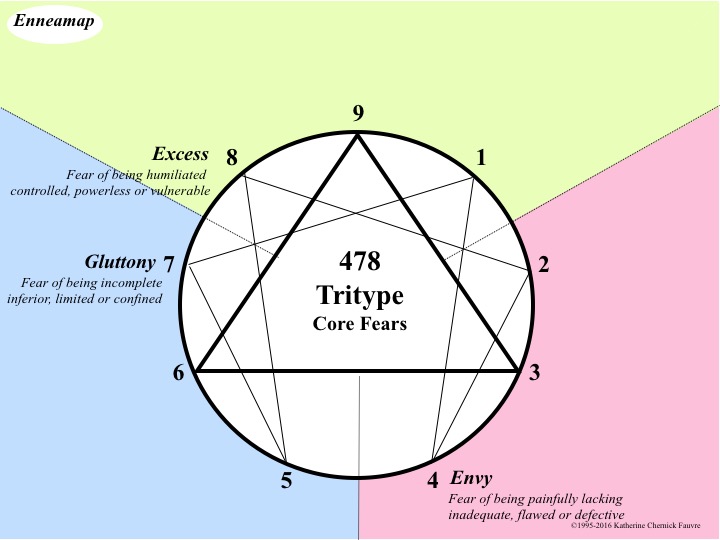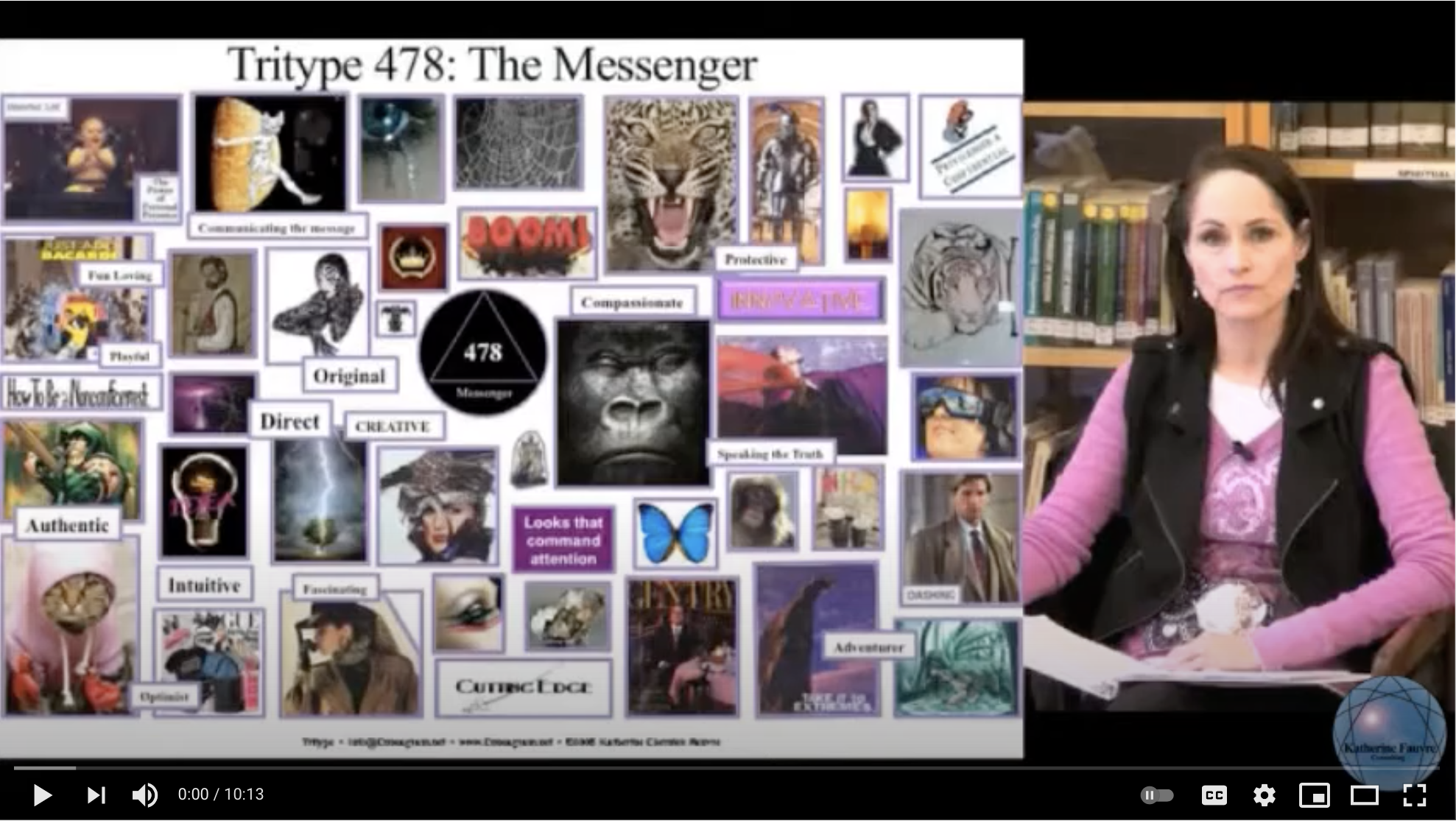Tritype® Events and Masterclass Recordings

Tritype® Relationships Q&A with Katherine Fauvre and Spencer Chernick Part 6
Learn how the Tritype® System explains specific nuances of type. Discover easy formulas to explain Tritype®. Watch Katherine and Spencer discuss how to use Tritypes® in relationships.
When: Coming Soon
Register By: to be announced
Time: 5:00-7:30 pm Pacific (California time)
Format: 2.5-hour online event
Fee: FREE (but must register to attend).
Registration link coming soon
If you wish to work with Katherine as a coach; book a session here. If you wish to work with Spencer Chernick as a therapist (California residents only), click here

Tritype® and Enneagram Masterclasses
Learn about the Enneagram, Tritype®, and more from Enneagram expert Katherine Chernick Fauvre. See all upcoming classes and recorded offerings.
Watch David Daniels and others discussing the benefits of Tritype®
"Katherine is an experienced, knowledgeable, and superb teacher of the Enneagram material. She works with care and compassion sharing her extensive experience in both coaching and teaching the Enneagram.
I hold her in high regard, and I support her work fully. Her interest in the internal style of type, Tritype and the connected instinctual subtype behaviors make her a leader in the field. Virtually everyone can benefit substantially from her research, classes, and workshops."
-David Daniels, MD, 621. >>watch here
Discover your blind spot, unlock your life purpose, and experience lasting change
Learning the Enneagram Tritype® System and understanding how to apply it to your life can open the door to rapid personal and professional growth that will positively impact every area of your life.
Learning the 27 Tritypes® brings a level of specific personalization that makes this possible.
In this Tritype® Masterclass, Katherine will use her 35+ years of Enneagram study, research, and coaching experiences to teach you the Enneagram Tritype® System. She has completed numerous research studies, three certification programs with the original Enneagram authors, and attended week-long intensives with both Oscar Ichazo and Claudio Naranjo. As a result, she has developed a diverse and integrated view of type.
What you will learn:
At the end of 10 weeks, you will have learned how people use all three centers of intelligence. This will empower you to make clear decisions quickly and understand where you and others are coming from. And, you will better understand how to recognize limiting beliefs, negative emotions, and repetitive behaviors.
Once you are aware of your Tritype®, Life Mission, Innate Strengths, Focus of Attention, and Inherent Blind Spots, then you can focus on your strengths and mitigate your weaknesses. Understanding the basic needs and concerns of the 27 Tritype® Archetypes will allow you to understand how to get the best from yourself and others.
Gaining more access to your individual path of transformation can lead you to your higher self. Absorbing the archetypal qualities of the 27 Tritype® Archetypes through imagery lets you more quickly and accurately type yourself and others.
Finally, you will gain a better ability to distinguish between common Enneagram look-a-likes, which can help avoid or clear up mistypings. Truly understanding which types you use and in which order you use them can help you understand what motivates you and others. Knowing why you think, feel, and act the way you do can radically increase your capacity for self-compassion and transformation.
Truly understanding which types you use and in which order can help you:
• Understand what motivates you and others. Know why you think, feel, and act the way you do… which can radically increase your capacity for self-compassion and transformation.
• Transform your relationships with others by understanding their unique personality type and what motivates them because you will know how to get the best from them.
• Move through your life with greater social effectiveness and gain more confidence because you know where people are coming from.
• Learn the tools that will enable you to draw out the best from everyone around you while you expand your compassion and ability to honor other people's approaches to life.
• Understand the important nuances about your natural strengths, weaknesses, and blind spots (making it easier for you to evolve, grow, and help others do the same).

Did you know you have three types, not just one?
And while one type is still dominant, you use each of your types in a very specific order.
Understanding each of your types in each of the three centers: head, heart, and gut explains the subtle personality differences within each type that can not be explained by one primary Enneagram type alone.
Tritype® explains the distinct differences from those who share the same type. For example, while the Tritype® 874 (type 8 that combines types 7 and 4) is a fast-paced, optimistic, creative, and emotional version of type 8, the Tritype® 826 is a more dutiful, loyal, and helpful version of type 8.
Tritype® also explains why people who share the same three Enneagram types have a natural affinity for one another. For example, the 126, 162, 216, 261, 612, and 621 are all focused on helping and being supportive of others regardless of which type is dominant.
In Katherine's own words...
I have had the good fortune of learning from many great teachers -- and to have certified with Helen Palmer-David Daniels, Don Riso-Russ Hudson, and Kathy Hurley-Theodorre Donson, as well as being able to attend intensives and study directly with the creator of the Enneagram, Oscar Ichazo, and the creator of the Subtypes, Dr. Claudio Naranjo.
I appreciate Oscar Ichazo's sharp mind and the way in which he created the Enneagram of Personality that we use today, and I have great respect for Dr. Claudio Naranjo, the first to actively disseminate Ichazo's information on the Enneagram of Personality and who is the originator of the Instinctual Subtypes. The time I studied with them greatly enriched my views of the types.
The original Enneagram did not explain the subtle differences in personality for those who share the same type and instinctual stacking...
So, I started researching. Initially, I researched the Enneagram Types, Instinctual Types, and Subtypes. This helped add key qualities to each type but still did not explain how those of the same type and instinctual subtype could still appear so different from one another. I wanted to know why and what could be learned to explain these differences and make it easier for people to type themselves and others.

Seeing this gap of knowledge, I developed a body of work I called Tritype® that is based on the meaningful contributions reported by the 9 Enneagram types themselves.
Through thousands of coaching sessions and reviewing tens of thousands of surveys and Enneacard test results, I developed a body of work that I call the Enneagram Tritype®.
How I discovered the Enneagram Tritype®
When I gathered data from my initial studies on the Types, the Instinctual Types, and Subtypes, I recognized a common pattern of clients and test-takers identifying with the core fears of three Enneagram types, not just one set of core fears.
At first, I thought this might be explained by someone's wing types or types along the lines of connection to the primary type. But far too frequently, the types were not connected by a wing or a line.
So, I just kept recording the patterns.
I even ran a mini-study focused on the core fears each type identified with to gather more data about the phenomena of people identifying with the core fears of three types. This was a pattern that other teachers had not noticed.
Yet what they had noticed was that some people were extremely hard to type because two or three types were so close. I hypothesized that Tritype® might explain this difficulty of why some types are so hard to determine and why some people strongly identify with more than one type.
"Tritype®" explains why people identify with more than just one type
People identifying three sets of fears rather than one also suggested to me that there was a reason people might identify with more than one type.
So, I began working with the interventions recommended for the three types they identified with, and my clients began to have faster results and more significant breakthroughs.
Not overthinking it, I simply called this TriCenter and 3Types and continued documenting my findings.
Then, in December 1996, after 11 years of Enneagram study, I attended a class given by a teacher from the Arica school, which was founded by Enneagram pioneer Oscar Ichazo.
The Arican instructor casually mentioned that she had something called a "tri-fix" but said nothing more. I had just heard this term a few weeks before from Jack Labanauskas and Andrea Isaacs that Ichazo now gave people three fixations.
After the class, I approached the Arican instructor and shared that I had found that my clients appeared to have the core fears of three types, and not just one and that they were always one from each center: head, heart, and gut.
Enneagram Pioneer Oscar Ichazo also recognized what he called "tri-fix" years after his initial dissemination of the Enneagram
The Arican instructor confirmed that my clients and findings were correct as Ichazo had also realized people have three fixations… not just one and that he too found the need to add the term "tri-fix" after his initial dissemination of the Enneagram.
As you can imagine, I asked where I could find Ichazo's information on tri-fix.
She said, "He only taught that you have three co-fixations used in a clockwise direction stemming from the primary Enneagram type and that there was nothing published on the subject."
Undeterred, I simply continued to record the nuances of the types that I had encountered with the first thousand clients I had introduced to the Enneagram system.
Over time, with my ongoing research, I confirmed that we do not use just one type but three types!
Each Enneagram type is an innate, elegant defense strategy built around a corresponding set of core fears. These core fears are based on the needs and concerns of the nine Enneagram types.
These core fears are based on the needs and concerns of the nine Enneagram types.
This dynamic is what gives rise to a complex personality structure and defense system. This is a unique way to understand the personality, not as ultimately a collection of traits and behaviors, but rather as an efficient defensive structure that is trying to manage our core fears and protect us from harm.
And of course, each of us can recognize in our own experience that we have more than one core fear, so being able to relate those different flavors of fear to a powerful map like the Enneagram Tritype® personality system is essential to truly understand what is driving each of us.
So, that is why I created the Tritype® System, a map that comprehensively lays out the major influences operating within our personalities which takes more of the mystery out of why people do what they do, which then makes it easier to better understand ourselves and others.

Guidance from Dr. Claudio Naranjo
In 1996, at the intensive with Claudio Naranjo, I gave Claudio my 1994-1995 research on the Instinctual Subtypes. He reviewed it, and he spent time discussing my research findings during the intensive.
It was at this time that he validated my research on the Subtypes.
I asked him a lot of questions. What was noteworthy was that he was totally open and available to any question I had about his knowledge of the Enneagram and the Subtypes.
Most of Naranjo’s information on the Subtypes was unknown in 1996, so I was surprised when he asked me to write a paragraph about each of the 27 Subtypes and add them to my book, Enneagram Instinctual Subtypes, so that his work would be represented.
Before I put it out there, I sent the paragraphs that I wrote to Naranjo – and he approved them. I also wrote an article about my experience since there was so much we learned about the Enneagram itself that he had not previously taught. Click here - Naranjo Article: Reflections on Type.
Tritype® is a complete "map" to the unconscious influences driving behavior
The journey of making progress in life requires being able to see and identify the things that we fear, our reactivity to situations, the beliefs that reinforce our reactivity, and our understanding of why we react to people and situations the way we do.
The Enneagram and the Tritype® System provide an incredible shortcut on the path of personal growth. Once we have identified our Enneagram Type and Tritype®, we have access to a map that clearly lays out many of the things we need to see and work with in order to become the happiest, most functional, and successful versions of ourselves.
We can, of course, get to all of this through in-depth self-inquiry, but having the benefit of a map like the Enneagram can cut years off the process.
Because once you know the Enneagram Tritype® System and learn to accurately identify the patterns of each type, you will be able to quickly understand the unique drivers inside each person in your life.
You gain immense power through understanding someone's Core Fears and motivations
Understanding Tritype® enables you to help others feel seen as well as know what they need, how to relate to them in the best way, and how to avoid triggering their unconscious fears and insecurities.
Developing a deep knowledge and understanding of your Enneagram Tritype® is like removing the fog of perception from your eyes, both for your own journey of personal development and with how you relate to everyone in your life.
The three types within your Tritype® intersect and create a defense strategy and type unto itself.
The Tritype® brings both assets and liabilities. The high side of the intersection of these three Enneagram types is that together they define what gives your life direction, focus, and a sense of purpose.
On the low side, this combination of your three types creates a predictable blind spot, which lowers your ability to accurately self assess (and may keep you locked in self-defeating patterns).

The 478 Tritype®
Here's a short video where Katherine discusses the 478 Tritype®. Keep in mind; there are a total of 27 possible Tritype® combinations. The 478 is just one.
As you can see from the video, the depths to which you can use the Tritype® System to truly understand people is nearly limitless… far beyond that of the Enneagram alone.
>>watch here
"Tritype® made my own coaching work with my clients so much deeper and so much faster,"
...said Iris, a coach, about working with the Enneagram Tritype® System. If you're a healer, therapist, life coach, leadership coach, business consultant, or spiritual director, using the Enneagram and Tritype® in your work will give you access to a level of individualized insights that can significantly accelerate your impact and return on investments with your clients.
If clients are accurately typed, clients will report significant changes in the way they view others and themselves.
By itself, Tritype® offers a deep understanding of our personality and comes alive when you apply it directly into your life
By itself, Tritype® is the map, but you also need to know how to follow that map to your destination.
Whether it is understanding yourself, breaking old patterns, or helping clients improve the quality of their lives, you need to know how to apply it to have the greatest results.
You will know how to correctly use your Tritype®, Life Mission, Innate Strengths, Focus of Attention, and Blindspot, as well as the basic needs and concerns of the 27 Tritype® combinations, so you can address each one and get the best from people.
Tritypes® with the same Instinct can even look-a-like!
You'll learn the archetypal qualities of the 27 Tritype® Archetypes through powerful visual imagery, so you can more accurately "type" people and know how to distinguish between common Enneagram look-a-likes to avoid common mistypings.
How the Tritype® Masterclass works
During the first hour, you will dive deep into Tritype® teachings. Through visual aids, images, and exemplars, you will learn highly effective formulas for understanding each center, each type's Core Fears, Idealized Images, and how the needs and concerns of three types intersect (in effect creating a "new" type unto itself with a more specific focus of attention).
You will also discover how each Type and Tritype® combine and what those sharing the same Tritype® say about what it means to have their Tritype®.
During the second hour of each class, you will break out into different dyads and groups so you can discuss how you relate to the material.
This is your time to connect with your peers and take the work deeper.
The last 20 to 30 minutes of the class will include live Q&A. Use this Q&A time to ask any and all questions you have about the Enneagram, Tritype®, or any of the material presented. There are no unimportant questions as each question reveals another layer that will help you and others understand the material.
Katherine uses her experience with micro-expressions, MBTI, body language, NLP, and more in your time together in order for you to integrate the Enneagram Tritype® teachings directly into your life.
The Enneagram Tritype® Masterclass counts towards Katherine's Certification Program, but you don't have to be on the certification path to take it.
In addition, you will get handouts to accompany the course. Katherine's goal is that you will walk away with a profound and lasting understanding of your internal experience of Type and Tritype® so you can create real transformation in your life, work, and relationships.
Tritype® 2.0 and beyond take the material to a much more advanced level. Discover the Masterclasses now.
©1995-2023 Katherine Chernick Fauvre



